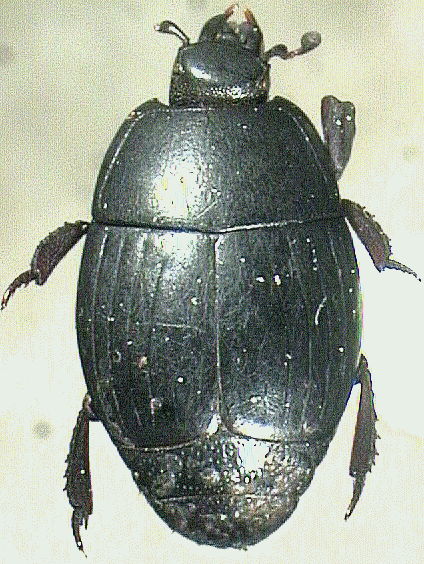Hister sedakovii Marseul (Fig. 6, 7, 8)
Hister sedakovii Marseul, 1861, 548; Jakobson, 1911, 645 [Korea]; Mazur,
1970, 59 [Korea]; Kryzhanovskij and Reichardt, 1976, 328 [Korea].
Hister sedakovi (sic): ESK & KSAE, 1994, 137 [Korea].
Hister czikanni Csiki in Horvath, 1901, 106, synonymized by Lewis, 1903,
425.
Hister falsus var. fraudator Bickhardt, 1912, 291, synonymized by Bickhardt,
1917, 185.
Redescription. (Ohara and Paik, 1998.)
Body oblong-oval, feebly convex, black and shiny; tibiae and antennae
reddish brown. Body length, PPL male 4.49 4.86 (4.58 ± 0.048)
7, female 4.93 5.27 (5.1 ± 0.17) 2, PEL male 3.67 4.05
(3.84±0.063) 7, female 3.74 4.66 (4.20 ± 0.459) 2; width
male 2.96 3.33 (3.11±0.051) 7, female 3.16 3.69 (3.40±0.238)
2. Biometric data given in Table 1.
Frontal stria complete and carinate, the anterior portion straight and
the lateral portion angulate; supraorbital stria absent; disk flat, finely
punctate, the punctures separated by 1 2 times their diameter, the
interspace between the punctures covered with alutaceous microsculpture.
Mandible with distinct carina on apicolateral side; disk depressed and coarsely
punctate.
Pronotal sides (Fig. 6C, D) regularly curved and convergent apically;
apical angle round. Marginal pronotal stria complete laterally and slightly
interrupted anteriorly on median one-third to one-fifth. Outer lateral stria
shortened on latero-basal one-fifth, and interrupted anteriorly on median
three-fifths. Inner lateral stria complete, the median portion feebly crenated.
Disk sparsely scattered with fine punctures, wholly covered with alutaceous
microsculpture. A row of coarse punctures present along the posterior margin.
Antescutellar area with a short longitudinal impression.
Epipleura of elytra excavated; marginal epipleural and marginal elytral
striae well impressed and complete; subhumeral stria wanting; oblique humeral
stria lightly impressed on basal third; first third dorsal elytral
striae complete, slightly abbreviated basally; the third slightly bent inwardly
on basal half; fourth dorsal stria shortened on basal one-third; fifth dorsal
stria variable, present on apical one-third to absent, usually present on
apical one-sixth; sutural stria present on apical half. Disk of elytra sparsely
covered with fine punctures, rarely with moderate punctures, that are separated
by about 3 times their diameter.
Propygidium irregularly covered with large, round, shallow punctures
that are separated by half to 4 times their diameter, the punctures becoming
finer and sparser medially; interstices between the punctures sparsely and
finely punctate. Pygidium convex, the anterior area flat; disk sparsely
covered with coarse punctures on basal area, the punctures separated by
1 to 2.5 times their diameter and become sparser apically.
Anterior margin of prosternal lobe round; marginal stria complete, another
short stria present laterally; disk of lobe convex medially and evenly covered
with coarse punctures that are separated by 1 to 3 times their diameter.
Prosternal keel convex; carinal stria absent; lateral stria completely impressed
and strongly carinate; disk coarsely punctate along lateral stria.
Anterior margin of mesosternum feebly emarginate, its marginal stria
distinctly impressed and carinate; another short stria present behind antero-lateral
angle on each side; disk sparsely covered with fine punctures that are separated
by 4 to 5 times their diameter. Meso-metasternal suture well impressed and
slightly carinate. Lateral metasternal stria completely impressed and carinate,
obliquely and posteriorly extended, and the apical end united with an oblique
stria that inwardly extends from the middle of the metasterna-metepisternal
suture; lateral disk densely covered with large, round, shallow and setiferous
punctures that are separated by one-third to half their diameter. Post-mesocoxal
stria of metasternum well impressed along posterior of mesocoxa and become
more distant from the margin laterally, the lateral portion nearly straight.
Punctation of intercoxal disk of metasternum similar to that of the intercoxal
disk of mesosternum. Intercoxal disk of first abdominal sternum completely
striate on each side, but the striae are usually slightly interrupted and
bent at middle.
Protibia with 4 denticles on outer margin, the basal one small and apical
one with 2 spinula. Meso- and metatibiae with 2 rows of 8 10 long
and stout spinula on outer margin.
Male genitalia as shown in Fig. 8. Aedeagus short and stout; lateral
sides of parameres straight on basal two-thirds, then a little divergent
apically at apical one-third , thence strongly convergent on apical one-sixth;
process on midline of ventral side well developed and strong; ratio of parameres
length to basal piece length about 2.81.
Material examined. Pyeonganbug-do: Taiyudong, 20/ix/1924 (1 ex.,
[NSMT-I-C-23214, Kono coll.], 1 male [EHU, Kono coll.], B. Efremoff), 1925
(1 male & 1 female [EHU, Kôno coll.], E. Gallois); Mt. Pong-san,
Pukdo, 22/vi/1997 (4 males & 1 ex., Kim); Shineuju City (= Sin-cu-ju),
northeast 2 km, 9/vii/1993 (4 exs., J. K. Lee). Seoul City: Seoul, 5/v/1922
(1 ex. [NSMT-I-C-23215, Kono coll.], no collector's name), 8/viii/1918,
5/iii/ 1919, (1 female, 2 exs. [EHU, Kono coll.], E. Gallois).
Remarks. H. sedakovii resembles H. coreanus; however, the large
body size, the short fourth, fifth and sutural dorsal striae of elytra,
and the shape of eighth sternum, spicule and aedeagus of the male genitalia
of H. sedakovii will distinguish it from H. coreanus.
Distribution. Korea; East Siberia; North China;
Mongolia.
Histeridae/Histerinae/Histerini/Hister/References
